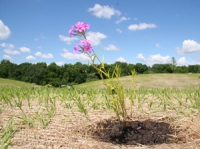We usually call “baby” plants seedlings or sporophytes depending upon the type of plant the offspring have emerged from. There are new plantings of baby plants at each of our three branches of the Urban Ecology Center. We are continuously improving the quality of wildlife habitat and outdoor educational space by removing non-native invasive species and planting to increase the biodiversity of native Wisconsin plant species. This habitat restoration happens very slowly over time.
In the 14 years I’ve worked at the Center, I’ve seen the ravine in Riverside Park go from a carpeting of invasive garlic mustard to one of the areas where native spring woodland wildflowers are most prolific. It is an amazing space to see new things popping up and blooming every week in the early growing season … everything — bloodroot, mayapples, toothwort, spring beauty, jack-in-the pulpit and more! Over the past year with the opening of Three Bridges Park, the Milwaukee Rotary Centennial Arboretum and an increase in plantings in Washington Park, we have planted thousands of “baby” grasses, wildflowers, shrubs and trees in our parks.
Habitat restoration is an exciting but challenging process. It’s hard to patiently wait for a mighty Burr Oak to grow! Many of these plants began as tiny seedlings in the past few years and need some time before we see them in full glory. But as we wait for a full prairie in Three Bridges Park, a mature woodland in Washington Park and a grand oak savanna in the Arboretum, we can see first-hand how ecosystems change over time.
Please, give those baby plants a chance and stay on the trails in our parks. They are putting a lot of energy into setting down good strong root systems. Each day, each week and each year we will see amazing changes occur in the landscape. It’s a beautiful thing to witness. Visit our sites regularly and observe these incredible changes happening in our parks as they are revitalized. Even better, volunteer to help us improve the habitat! Check out our website for regular Land Stewardship volunteer drop-in times at each of our branches.





